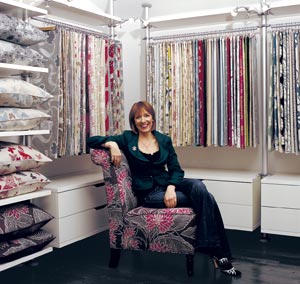 |
|
Lucy Rose Singh on a chair upholstered in Rapture & Wright, one of the modern British lines she represents in the U.S. |
Ask most Americans what they think of British design and "they do Laura Ashley in their heads," laments Lucy Rose Singh, who is about to personally change all that. She recently opened a showroom on the second floor of Crosell & Co. in Bucktown, where she offers-exclusively in the United States-fabrics, wallcoverings, and rugs that are decidedly more Stella McCartney than Laura Ashley, more Tate Modern than National Gallery.
"The designers I represent all have a very modern take on the English look," she explains. "They’re still grounded in the old English Arts and Crafts tradition-hand-printing their fabrics and often working out of small workshops in the countryside-but they’re making things that are cool and different, with funky patterns and fashionable colors."
Singh knows from fashionable. As a child, she split her time between Notting Hill ("when no one lived there") and an 18th-century Georgian house outside of Marlborough. Her parents (her mother a writer, her father a tailor on Saville Row) were stylish and a little Bohemian. "They were always on the edge of things; they had a lot of friends who were artists and fashion types," she explains. "People like Jack Nicholson would come by for lunch. My father made a suit for Twiggy."
When Singh grew up and followed her lifelong dream of becoming a decorator, her circles soon became just as tony-while apprenticing for the distinguished British interior designer David Mlinaric (who did homes for the Rothschilds and Lady Diana Spencer’s family), she assisted on Mick Jagger’s chateau in the Loire Valley in France. Since then, her own business has taken her from London to Florida to her charming new atelier in Bucktown, called, simply, Lucy Rose Design, where she recently sat down with us and eagerly debunked the myth of British design being all, in her words, "roses and chintz."
What’s the connection between traditional and modern British design? All along, English design has taken its cue from landscapes and gardens, but the 21st-century British look is a more sophisticated, stylized way of looking at flora and fauna. There’s a move back to nature, but not in a granola-and-brown- sandals way. For example, I carry this line called Rapture & Wright, by a young couple living in the Cotswolds in England, and they have this very fresh, modern pattern with birds and butterflies, and it’s all hand-printed onto linen. You are a fan of adding a twist to the traditional when decorating a room-how might you do this? I would use a very modern fabric, like one of Celia Birtwell’s whimsical, fashion-forward designs, with a very classical window treatment, such as Roman blinds. Or I would put a simple slipcover on a very comfortable, deep, traditional sofa and cover it with modern pillows. I would also cover a very traditional wing chair in a funky fabric. How does the American approach to design differ from the British? The British tend not to buy new stuff. They’re more likely to buy a good sofa once, and then recover it several times. There’s more economy involved in redecorating-putting a new lampshade on an old lamp, or reframing pictures to freshen up. Traditional English interiors always seem to mix patterns and stripes and flowers so unabashedly-how does one do that and not make it look ridiculous? I would avoid mixing and matching from the same range in a given line-use different brands. Choose a few colors you like and then combine a bold stripe from one designer, flowers from another, and something with leaves on it from a third. And don’t use fabrics with the same color background-you don’t want the fabrics to blend, because then it looks too same-y, too neutral. You always want to have a bit of fun, to do the unexpected. What about wallpaper and paint? I would absolutely use bold wallpaper in hallways, in the powder room, and in the dining room, but not in the bedroom. For the other rooms, I would have white doors and white trim with color on the walls. I tend to add burnt umber to any color I get to make it more muted. But I hate beige. So, what exactly is a drawing room? In Britain, the living room is referred to as the drawing room. Everyone has a drawing room in England. Lucy Rose Design, 1922 N. Damen Ave., 773-278-2282, lucyrosedesign.com
Photograph: Audrey Cho


